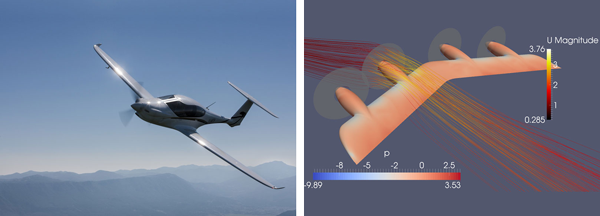Matej Andrejašič (Pipistrel), Žiga Povalej and Daniel Vladušič (XLAB)
Pipistrel is an SME based in Slovenia. It was established in 1989 and is a leading designer and manufacturer of light aircrafts. In order to design a new aircraft, Pipistrel needs to understand how the airflow behaves when passing the aerodynamic surfaces. There are two ways of doing this: the first one is a wind tunnel test using a scaled model and the second one is to simulate the flow of air on a computer using Computational Fluid Dynamics (CFD) simulations. Although both methods have pros and cons, the standard practice for large companies in the aerospace industry is to use both consecutively: CFD for research and physical testing for validation of the CFD models. These two phases are repeated until a satisfactory result is obtained. Obviously, wind tunnel use is very expensive and is used comparatively rarely (only at certain phases of design). The majority of the aircraft design is thus done using simulations. This is particularly true at Pipistrel - as a small niche aircraft provider it is virtually cut out of the wind tunnel testing, because such tests are simply too expensive. On the other hand, Pipistrel is delivering aircrafts with highly efficient aerodynamics. This means, Pipistrel has to simulate the flow of air as accurately as possible using a high-performance computer.
Pipistrel is currently limited to a small in-house cluster, that is why it is exploring different options in order to increase the fidelity and reduce the calculation time of its CFD simulations. Such simulations are of two types: The first type consists of computationally very intensive simulations. These incorporate numerical schemes and physical models that describe the real airflow in a more accurate manner than simulations typically run by Pipistrel. The second type of simulations on the other hand use the same simulation set-ups as typically run on Pipistrel’s in-house cluster but enable it to run a larger number of simulations at the same time.
Pipistrel was able to explore both types of simulations - the first ones were tested through the European FP7 Fortissimo project whereas the second one are currently being explored through H2020 MIKELANGELO project.

Foto: Pipistrel_Panthera in flight, MIKELANGELO Airflow
Fortissimo is a large collaborative project (123 partners) that enables European SMEs to be more competitive globally through the use of simulation services running on HPC cloud infrastructure. Its goal is to overcome the SMEs’ impasse through the provision of simulation services and tools running on an HPC infrastructure. To reach this objective, a sustainable “one-stop-shop” pay-per-use ecosystem called Fortissimo Marketplace is being developed. The main contributions and requirements needed for the development are provided from the experiments – targeted users of the Fortissimo Marketplace.
The vision of MIKELANGELO is to improve responsiveness, agility and security of the virtual infrastructure. The focus is on improvement of virtual I/O in SuperKVM and OSv, the light-weight operating system, with additional glue efforts in the fields of security, application packaging, delivery and finally, integration. The goal of the project is to unify Cloud and HPC under one technology stack, bridging the gap in speed and flexibility.
Fortissimo allowed Pipistrel to use large-scale HPC for the very first time (instead of using under-performing in-house cluster) and to learn and explore the capabilities of true HPC. This means, Pipistrel was able to run computationally very demanding, high fidelity simulations, extending the fidelity several orders of magnitude to those previously attainable with its in-house systems. These simulations closely modelled real-world behaviour and gave more accurate information on how the aircraft would behave in flight. Business gains of using HPC were only coarsely quantified, as Pipistrel is a company, able to win highly-prized awards (e.g., won the NASA Green Flight Challenge) - the multiplication effects of efficient aerodynamics research and design thus cannot be appropriately quantified nor limited.
On the other hand, Pipistrel entered MIKELANGELO project, to explore the possibility to use more flexible HPC and also Cloud infrastructures. Through appropriately packaging OpenFoam (CFD package), MIKELANGELO enables Pipistrel to use cloud infrastructure to run a large number of simpler simulations. Such a need arises in an industrial environment when a particular aerodynamic configuration, such as an aircraft, needs to be analysed under a set of conditions. These can be a varying angle of attack, sideslip angle or a propeller thrust. MIKELANGELO will therefore enable Pipistrel to obtain larger set of data in the same timely manner.
Both projects will allow Pipistrel to gain considerable expertise in the use cloud and cloud based HPC simulations. This experience will help Pipistrel to estimate the time and the cost of such simulations in future projects.
Acknowledgment: The authors would like to express appreciation for the support of the sponsors: MIKELANGELO project - 645402 and Fortissimo project - 609029.
Pipistrel d.o.o. Ajdovščina, Slovenia
E-mail: [email protected]
XLAB d.o.o., Slovenia
E-mail: [email protected], [email protected]








